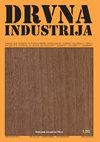Influence of Wood Surface Preparation on Roughness, Wettability and Coating Adhesion of Unmodified and Thermally Modified Wood
IF 0.8
4区 农林科学
Q4 MATERIALS SCIENCE, PAPER & WOOD
引用次数: 3
Abstract
In this research, the influence of face milling, sanding and UV irradiation of the hornbeam and ash wood sample on the wetting and adhesion strength of solvent-based and water-borne coating was studied. The adhesion of coatings to substrates is one of the most important parameters for finishing quality and service life of wood coatings, while wetting properties are usually used to assess the quality of surfacing process and could also provide important information on the adhesion ability of coatings. Surface roughness, contact angle of coatings and water as well as adhesion strength of coatings were tested on differently prepared (face milled, sanded and UV irradiated) samples of unmodified and thermally modified ash and hornbeam wood. Surface roughness was measured with stylus-type profilometer over the traverse of 12.5 mm and with a cut-off value of 2.5. Contact angle was measured using the sessile drop method 2 s, 10 s and 30 s after the application of the liquid drop on the sample surface, and adhesion strength was measured according to ASTM D4541. Results showed that sanding of hornbeam and ash wood resulted in the least rough surface compared to the face milled and UV irradiated surface. Contact angles of the water-borne coating were on average three times higher than the contact angles of the solvent-based coating. Sanding the surface of hornbeam and ash samples increased the adhesive strength in relation to the face milled surface, while UV irradiation of the sanded surface decreased the adhesive strength of most samples coated with solvent-based coating.木材表面处理对未改性和热改性木材粗糙度、润湿性和涂层附着力的影响
在本研究中,研究了角梁木和灰木样品的面磨、砂和紫外线照射对溶剂型和水性涂料润湿性和粘附强度的影响。涂料与基材的附着力是决定木器涂料涂饰质量和使用寿命的重要参数之一,而润湿性能通常是评价表面处理质量的重要指标,也是反映涂料附着力的重要指标。对未改性和热改性灰木和角梁木的不同制备(面磨、砂磨和紫外线照射)样品进行了表面粗糙度、涂层与水的接触角以及涂层的粘附强度测试。表面粗糙度用触针式轮廓仪测量,横移12.5 mm,截止值为2.5。液滴作用于试样表面后2 s、10 s、30 s,采用固滴法测量接触角,并按ASTM D4541测定粘接强度。结果表明,磨砂处理的角梁木和白蜡木表面粗糙度最小,而磨砂处理的角梁木和白蜡木表面粗糙度最小。水性涂料的接触角比溶剂型涂料的接触角平均高3倍。对角梁和灰分样品表面进行砂处理,相对于平磨表面,其粘接强度有所提高,而对砂处理表面进行紫外线照射,其粘接强度降低。
本文章由计算机程序翻译,如有差异,请以英文原文为准。
求助全文
约1分钟内获得全文
求助全文
来源期刊

Drvna Industrija
MATERIALS SCIENCE, PAPER & WOOD-
CiteScore
1.80
自引率
9.10%
发文量
32
审稿时长
>12 weeks
期刊介绍:
"Drvna industrija" ("Wood Industry") journal publishes original scientific and review papers, short notes, professional papers, conference papers, reports, professional information, bibliographical and survey articles and general notes relating to the forestry exploitation, biology, chemistry, physics and technology of wood, pulp and paper and wood components, including production, management and marketing aspects in the woodworking industry.
 求助内容:
求助内容: 应助结果提醒方式:
应助结果提醒方式:


